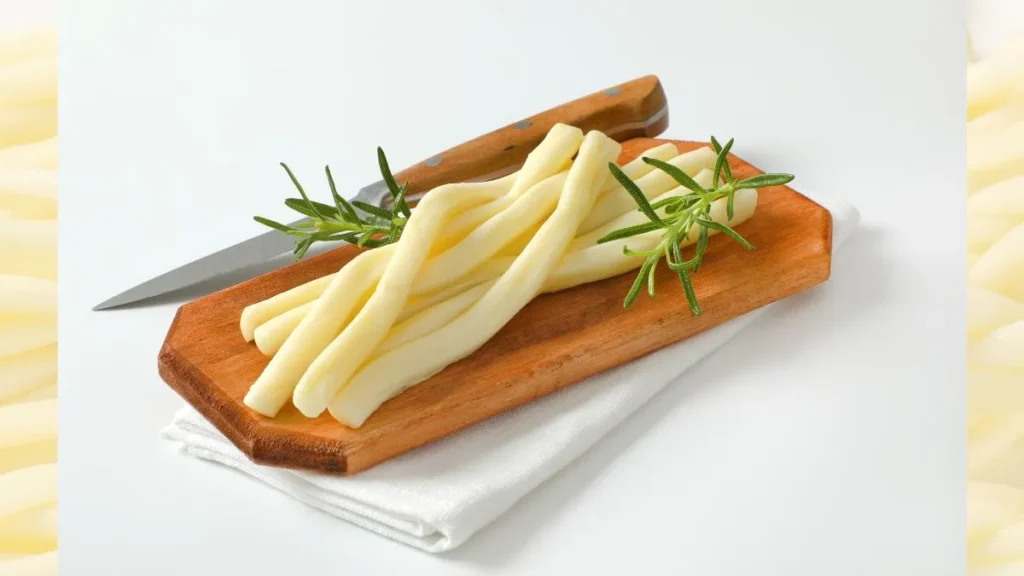The ever-present and beloved string cheese has cemented its position as a culinary superstar, especially among the younger generation. The interesting process of heating and stretching creates the unique texture of this delicious treat, yielding a wide variety of variations that reflect the cultural diversity seen throughout the world.String cheese has surpassed national boundaries and embraced a multitude of flavors and textures, from the fragrant korbáčiky in Slovakia to the tongue-tickling dil peyniri in Turkey and the seasoned chechil in Armenia.
Contents
- The Science Behind Stringiness:
- Central Europe: Korbáčiky in Slovakia:
- Eastern Europe/West Asia: Dil Peyniri in Turkey, Chechil in Armenia:
- Georgia and Russia: Tenili:
- Western Europe: Cheestrings in the UK and Republic of Ireland:
- North America: String Cheese in Mexico and the United States:
- Central America and Caribbean: Queso de Hoja in the Dominican Republic:
- Oceania: Bega Stringers in Australia:
The Science Behind Stringiness:
The complicated change that string cheese experiences when heated to 60°C (140°F) and then painstakingly stretched is the secret to its particular appeal. The distinctive stringy texture of milk is caused by this process, which aligns the milk proteins. For cheese lovers all across the globe, the finished result is the ultimate snack food since it is stringy, chewy, and firm.
Central Europe: Korbáčiky in Slovakia:
Slovakia, situated in the center of Central Europe, produces Korbáčiky, a salty sheep milk cheese available in both smoked and unsmoked versions. Skilled artisans hand-braid this exquisite treat, crafting it from steamed sheep’s cheese. You can also find it made from cow’s milk.
Zázrivá, renowned as the center for cheese production, showcases the traditional art of manufacturing korbáčiky.In the adjacent regions of South Poland, you can find cheeses that are similar.
Eastern Europe/West Asia: Dil Peyniri in Turkey, Chechil in Armenia:
Turkey is home to dil peyniri, sometimes known as “tongue cheese,” a soft white cheese produced from cow’s milk that takes on a distinct stringiness when melted. Armenia produces the classic string cheese, chechil, with a white base, typically derived from aged sheep or goat milk. Crafted in an infinite loop braid, this dish undergoes seasoning with mahleb and black cumin, intensifying its flavor as it undergoes the pulling process.The Armenian diaspora’s culinary influences are reflected in the crafting of this cheese, which is also undertaken in Syria and Turkey.
Georgia and Russia: Tenili:
In Russia and Georgia, string cheese is called tenili. Crafted with fermented sheep’s milk and cream, this cheese reveals the distinctive cheese-making traditions of the area as it ages for 60 days in a salted and dried veal stomach.
Western Europe: Cheestrings in the UK and Republic of Ireland:
The introduction of cheestrings in 1996 caused quite a stir in the United Kingdom and the Republic of Ireland. These cartoon-like treats, created by the Kerry Group using actual cheese rather than processed cheese, have a mascot named Mr. Strings. Cheestrings offers Original, resembling mozzarella in taste, and Twisted, featuring two colors. To celebrate Cheestrings’ 25th anniversary in May 2021, Pizza flavor, along with smoky bacon and cheddar, will make a comeback.
Gouda cheese from Charleville, located in the county of Cork, is known and exported to the Netherlands.Ficello, a blend of Gouda and Emmental, goes to France. In the past, Tesco and Dairylea, as well as Dunnes Stores, manufactured inexpensive cheddar Cheestrings in the UK.
In addition, Kerry Cheestrings’ Attack-A-Snack has been on the market since the late ’90s and competes with Dairylea Lunchables; it comes with a tortilla wrap or cracker, a sachet of tomato ketchup, and processed ham.
North America: String Cheese in Mexico and the United States:
Leobarda Castellanos García created the initial variety of string cheese in Mexico in 1885.Quesillo, often called “Queso Oaxaca,” is a staple in Mexican cuisine and comes in a variety of sizes of balls.
String cheese, as used in American parlance, is usually short, cylindrical pieces of low-moisture mozzarella that are around 6 inches in length and used as snacks. In 1976, Frank Baker came up with this type of string cheese. It’s exciting and engaging since you can pull it into strings along its length.
Central America and Caribbean: Queso de Hoja in the Dominican Republic:
“Queso de Hoja,” a Caribbean spin on the ubiquitous ball-shaped string cheese, is a Dominican specialty that brings a unique flavor to toast or crackers.
Oceania: Bega Stringers in Australia:
Bega Stringers, introduced in Australia by Bega Cheese, are a part of the worldwide string cheese craze.
A special kind of string cheese called Sea King String, made using buffalo milk and proteins extracted from breadfruit, graces the Marquesas Islands.
Conclusion:
String cheese is a monument to the rich fabric of culinary traditions around the world, with its interesting production process and numerous worldwide variations.
Each country has forever changed this famous food, from Armenia’s tasty chechil to Slovakia’s hand-pulled korbáčiky.
String cheese, in all its forms, continues to enchant palates around the world, demonstrating that the pleasure of cheese has no limits.
In honor of the stringy feeling that unites people all over the world, it’s clear that string cheese is now a staple in cuisines all over the world.











